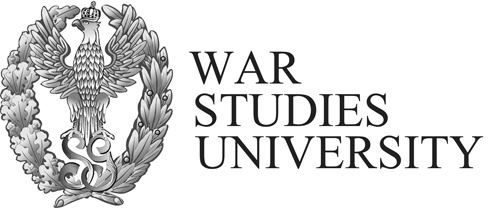Online first
Current issue
All issues
About
Aims and scope
Peer review process
Publication policy and ethics & malpractice statement
Editorial Board
Reviewers
Publisher
Guide for authors
Call for papers
Book Reviews
Special Issues Archive
New and emerging technologies in defence education, training and governance
RESEARCH PAPER
Critical infrastructure in the shaping of national security
1
Wydział Bezpieczeństwa, Logistyki i Zarządzania, Wojskowa Akademia Techniczna, Poland
Submission date: 2020-02-17
Acceptance date: 2020-02-29
Online publication date: 2020-03-17
Publication date: 2020-03-26
Corresponding author
Ewa Żaboklicka
Wydział Bezpieczeństwa, Logistyki i Zarządzania, Wojskowa Akademia Techniczna, Kaliskiego 2, 00-908, Warszawa, Poland
Wydział Bezpieczeństwa, Logistyki i Zarządzania, Wojskowa Akademia Techniczna, Kaliskiego 2, 00-908, Warszawa, Poland
Security and Defence Quarterly 2020;28(1):70-81
KEYWORDS
TOPICS
ABSTRACT
Critical infrastructure plays a key role in ensuring the national security of a state, due to important functions thereof in
military, economic, and public administration sectors. The destruction, damage, failure or other deprivation of critical infrastructure of its operational capabilities constitutes a direct threat to the structural and personal security of the state. The
research methods and techniques implemented in the research process itself primarily hinge on critical analysis of acts of law
and organisational and competence-related documents, subject-matter literature, synthesis and inference in order to reach
the formulated objectives based on efficiency criteria. The main findings indicate that critical infrastructure is perceived as
a set of systems which exerts a substantial impact on the security of the state and, obviously, its inhabitants. The results
advocate for a reflection that critical infrastructure embraces a number of facilities which appear to be remarkably diverse.
They are buildings, structures, installations, equipment and services which, integrally, form cohesive systems which allow
the proper functioning of a given state. It is the state whose role is just to supervise and coordinate, whereas the operators of
critical infrastructure are the ones who are to protect it. The overall findings of this paper present the notion that safeguarding critical infrastructure is a task of crucial importance to the national security of a state and, therefore, it would be worth
reconsidering the intensification of rules which apply to the infrastructure of national security and its efficient functioning.
REFERENCES (18)
1.
Bielawski, R., Rządkowski, R. and Perz, R. (2018) ‘Unmanned Aerial Vehicles in the protection of the elements of a country’s critical infrastructure – selected directions of development’, Security and Defence Quarterly, 22(5), pp. 3–19. doi:10.5604/01.3001.0012.6422.
2.
Dessers, E. (2014) Spatial Data Infrastructures at Work: Analysing the Spatial Enablement of Public Sector Processes. Leuven: Leuven University Press.
doi: 10.2307/j.ctt9qf068.
3.
Domalewska, D. (2019) ‘The role of social media in emergency management during the 2019 flood in Poland’, Security and Defence Quarterly, 27(5), pp. 32-43. doi: 10.35467/sdq/110722.
4.
Fay, J. and Patterson, D. (2017) Contemporary Security Management. Oxford: Butterworth-Heinemann. doi:10.1016/C2015-0-04732-3.
5.
Knapp, E. and Langill, J.T. (2011) Industrial Network Security: Securing Critical Infrastructure Networks for Smart Grid, SCADA, and Other Industrial Control Systems. Rockland: Syngress. doi: 10.1016/C2010-0-66555-2.
6.
Landucci, G., Khakzad, N., and Reniers, G. (2020) Physical Security in the Process Industry: Theory with Applications. Burlington: Elsevier.
doi: 10.1016/C2017-0-00539-6.
7.
Li, W., Kodeswaran P., Jagtap, P., Joshi, A. and Finin, T. (2012) ‘Managing and Securing Critical Infrastructure – A Semantic Policy- and Trust-Driven Approach’, in Das, S.K., Kant, K. and Zhang, N. (eds.) Handbook on Securing Cyber-Physical Critical Infrastructure: Foundations and Challenges. San Francisco: Morgan Kaufmann, pp. 551-573. doi: 10.1016/C2011-0-04434-4.
8.
Narodowy Program Ochrony Infrastruktury Krytycznej (NPOIK) (2015) Warsaw: Rządowe Centrum Bezpieczeństwa.
9.
Pesch-Cronin, K.A. and Marion, N.E. (2016) Critical Infrastructure Protection, Risk Management, and Resilience: A Policy Perspective. Boca Raton: CRC Press.
doi: 10.1201/9781315310657.
10.
Polinpapilinho, F.K. and Hester, P.T. (2012) ‘Systemic determination of infrastructure criticality’, in Thissen, W.A.H., and Herder, P.M. (eds.) Critical Infrastructures State of the Art in Research and Application (International Series in Operations Research & Management Science Book 65). Dordrecht: Springer. doi: 10.1007/978-1-4615-0495-5.
11.
Purpura, P. (2013) Security and Loss Prevention. Burlington: Butterworth-Heinemann. doi: 10.1016/C2010-0-69612-X.
12.
Pyznar, M. (2010) ‘Narodowy Program Ochrony Infrastruktury Krytycznej w systemie ochrony tej infrastruktury – wizja Rządowego Centrum Bezpieczeństwa’, in Tyburska, A. (ed.) Ochrona infrastruktury krytycznej. Szczytno: Wydawnictwo Wyższej Szkoły Policji.
13.
Rogers, R., Miles, G., Fuller, E. and Dykstra, T. (2004) Security Assessment: Case Studies for Implementing the NSA IAM. Rockland: Syngress Publishing.
14.
Radziejewski, R. (2014) Ochrona Infrastruktury Krytycznej. Teoria a praktyka. Warsaw: Wydawnictwo Naukowe PWN.
15.
Stanley, J.R., Stanley, J.K. and Hansen, R. (2017) How Great Cities Happen: Integrating People, Land Use and Transport. Cheltenham UK & Northampton USA: Edward Elgar Pub. doi: 10.4337/9781784718398.
16.
Szczurek, T. (2019) Wyzwania dla bezpieczeństwa – niepewna przyszłość – między zagrożeniami a szansami. Warsaw: Military University of Technology.
17.
The law of 22 August 1997 on the protection of people and of property (Journal of Laws of the Republic of Poland Dz.U. 2016 Item 1432, as amended).
18.
Wiles, J. (2008) Techno Security’s Guide to Securing SCADA: A Comprehensive Handbook On Protecting The Critical Infrastructure. Rockland: Syngress.
doi: 10.1016/B978-1-59749-282-9.X0001-2.
CITATIONS (5):
1.
Intelligent terrorism as a security threat to critical infrastructure
Ossi Heino
Security and Defence Quarterly
Ossi Heino
Security and Defence Quarterly
2.
Innovations in Mechatronics Engineering III
Petru Urs, Mihai Hulea, Mihail Abrudean, Vlad Muresan
Petru Urs, Mihai Hulea, Mihail Abrudean, Vlad Muresan
3.
Private security resources for critical infrastructure protection in urban conditions
Jana Marković
Urbana bezbednost i urbani razvoj, Zbornik radova sa trece naucne konferencije - zbornik radova
Jana Marković
Urbana bezbednost i urbani razvoj, Zbornik radova sa trece naucne konferencije - zbornik radova
4.
Intelligent Transport Systems: Ecology, Safety, Quality, Comfort
Jacek Strojny, Nataliia Bondar, Vladyslav Umantsiv, Ievgeniia Sagaidak, Viktoriia Sukmaniuk
Jacek Strojny, Nataliia Bondar, Vladyslav Umantsiv, Ievgeniia Sagaidak, Viktoriia Sukmaniuk
5.
Countering Hybrid Threats Against Critical Infrastructures
Konstantinos Papatheodorou, Carmine Baruffo, Nimet Bölgen, Marijana Hadzima-Nyarko, Ashok Vaseashta, Alina Bărbulescu, Dorin Radu, Konstantinos Ntouros, Elena Tzanou, Mirko Rocca
Konstantinos Papatheodorou, Carmine Baruffo, Nimet Bölgen, Marijana Hadzima-Nyarko, Ashok Vaseashta, Alina Bărbulescu, Dorin Radu, Konstantinos Ntouros, Elena Tzanou, Mirko Rocca
Share
RELATED ARTICLE
We process personal data collected when visiting the website. The function of obtaining information about users and their behavior is carried out by voluntarily entered information in forms and saving cookies in end devices. Data, including cookies, are used to provide services, improve the user experience and to analyze the traffic in accordance with the Privacy policy. Data are also collected and processed by Google Analytics tool (more).
You can change cookies settings in your browser. Restricted use of cookies in the browser configuration may affect some functionalities of the website.
You can change cookies settings in your browser. Restricted use of cookies in the browser configuration may affect some functionalities of the website.




